Please report any broken links or trouble you might come across to the Webmaster.
Please take a moment to let us know so that we can correct any problems and make your visit as enjoyable and as informative as possible.
| Click On Image For Full Size | Size | Image Description | Source | |
|---|---|---|---|---|
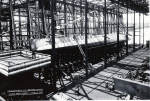 | 255k | The submarine H-2 (SS-29) is shown ready for launching at Union Iron Works, San Francisco on 4 June 1913. | USN photo courtesy of Darryl L. Baker. | |
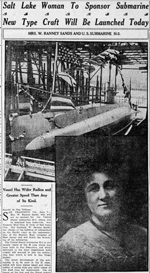 |
NR | Bay Waters Baptize New Submarine Diving Craft Prepares for Trial. Submarine torpedo boat H-2 (SS-29) leaving the ways at the Union Iron Works and Mrs. W. R. Sands who christened the diving warship. Vessel Is Second Launched Here of Class Which Surpasses All Others in Speed and Efficiency |
Image and text provided by University of Utah, Marriott Library & University of California, Riverside. Photo from The Salt Lake Tribune. (Salt Lake City, Utah) 1890-current, 04 June 1913, Image 1 & The San Francisco Call. (San Francisco {Calif.]) 1895-1913, 5 June 1913, Image 2, via chroniclingamerica.loc.gov. | |
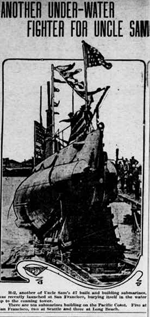 |
1.37k | Another under water fighter for Uncle Sam. H-2 (SS-29), another of Uncle Sam's 47 built and building submarines, was recently launched at San Francisco, burying itself in the water up to the conning tower. There are ten submarines building on the Pacific Coast. Five at San Francisco, two at Seattle and, three at Long Beach. |
Image provided by: Washington State Library; Olympia, WA. Photo from The Tacoma Times.(Tacoma, Wash.) 1903-1949, 25 June 1913, Image 8, via chroniclingamerica.loc.gov. | |
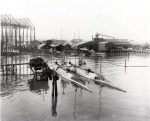 | 97k | H-1 (SS-28) and H-2 (SS 29), are berthed at Union Iron Works, San Francisco on 7 Oct 1913 after being launched at that shipyard in May and June of 1913. | USN photo courtesy of Darryl L. Baker. | |
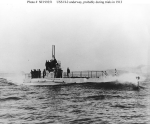 | 74k | H-2 (SS-29) underway, probably while running trials in California waters, 1913. | Official USN photo # NH 99351, from the collections of the Naval Historical Center. | |
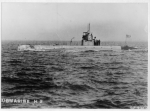 | 125k | H-2 (SS-29) underway off the Mare Island Navy Yard, California, 30 January 1914. | USN photo # 19-N-13667, from (NARA), courtesy of Daniel Dunham. | |
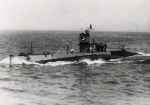 | 336k | H-2 (SS-29) underway off the Mare Island Navy Yard, California, 30 January 1914. | Courtesy of chinfo.navy.mil / US Naval Historical Center # NH 45620. | |
 | 173k | H-1 (SS-28), H-2 (SS-29) and H-3 (SS-30), berth together at an unknown location in January 1914. They possibly could be nested alongside of the Cheyenne(BM-10) which was the tender for the three subs. | USN photo courtesy of Darryl L. Baker. | |
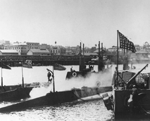 | 81k | Cheyenne (BM-10) with H-3 (SS-30), H-1 (SS-28) and H-2 (SS-29) alongside, probably at San Diego, California, circa 1914-1917. Note the submarines' 13-star "boat" flags, and the numbers "23", "21" and "22", on their periscope housings. The first digit of these numbers represents the Second Torpedo Flotilla, to which they were assigned. The second digit represents the individual submarine's name. Also note the Sailor seated on Cheyenne's port anchor. | Text courtesy of USNHC photograph # NH 76004. USN photo courtesy of Scott Koen & ussnewyork.com. |
|
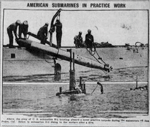 |
NR | AMERICAN SUBMARINES IN PRACTICE WORK Above the crew of U. S. submarine H-2 (SS-29) hoisting aboard a spent practice torpedo during the maneuvers off San Pedro, Cal. Below is submarine H-3 (SS-30) rising to the surface after a dive. | Image and text provided by University of Nebraska-Lincoln Libraries, Lincoln, NE. Photo from The North Platte Semi-Weekly Tribune.(North Platte, Neb.) 1895-1922, 11 June 1915, Image 9, via chroniclingamerica.loc.gov. | |
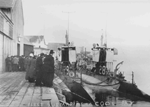 | 202k | The submarines H-1 (SS-28) & H-2 (SS-29) moored in Coos Bay, Oregon sometime between 1914-1917. | Photograph courtesy of Robert Hurst. | |
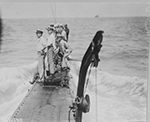 |
362k | Aboard the Submarine H-2 (SS-29) showing crew and officers, 5 March 1918. | Photo by Lt. H.P. Kingsmore. National Archives Identifier: 55173998 Local Identifier: 111-SC-006592. Photo courtesy of catalog.archives.gov | |
 | 302k | The submarine H-2 (SS-29) as in 1918, displays the standard WW I "chariot" bridge but not standard wartime listening equipment. | Drawing by Norman Friedman. Photo & text courtesy of U.S. Submarines Through 1945, An Illustrated Design History by Norman Friedman. Naval Institute Press. | |
 | 82k | The monitor Cheyenne (BM-10) with two of her charges H-2 (SS-29), H-3 (SS-30) in 1916. | USN photo courtesy of Robert M. Cieri. | |
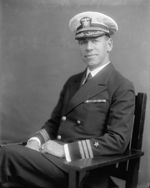 | 98k | Lt. Frederick Carl Sherman served as commanding officer of submarines H-2 (SS-29) and O-2 (SS-63) during World War I. | Photo # 19471v courtesy of the Library of Congress via Bill Gonyo. | |
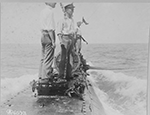 | 258k | Key West Naval Station: Submarine practice diving, - signalling from the deck of the H-2 (SS-29), 5 March 1918. | Photo by Lt. H.P. Kingsmore. National Archives Identifier: 55174000 Local Identifier: 111-SC-6593. Photo courtesy of catalog.archives.gov | |
 |
656k | Half full, half empty. H-2 (SS-29) at the Submarine base, New London, CT. | Photo courtesy of Reginald Flemming Landrum via Lillie Bavendam. | |
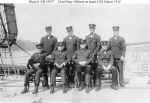 | 81k | Chief Petty Officers of the H-2 (SS-29) photographed on board the Fulton AS-1 at the New London submarine base, Groton, Connecticut, in 1919. The conning tower of H-2 is visible in the right background. | US Naval Historical Center # NH 53977. | |
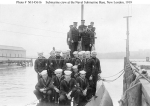 | 75k | Crew of the H-2 (SS-29) on board their "boat" at the New London submarine base, Groton, Connecticut, in 1919. The submarine is possibly H-2. | US Naval Historical Center # NH 45616. | |
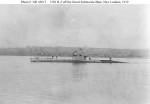 | 53k | H-2 (SS-29) off the New London submarine base, Groton, Connecticut, in 1919. | USNHC photograph # NH 45617. | |
 | 81k | H-2 (SS-29) at the New London submarine base, Groton, Connecticut, in 1919. This photograph has been annotated to identify H-2's radio antenna installation, and features an associated diagram. | This image was used in Rear Admiral R.S. Griffin's "History of the Bureau of Steam Engineering". USNHC photograph # NH 45618. | |
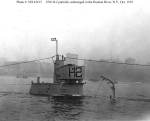 | 73k | H-2 (SS-29) partially submerged in the Hudson River, while on recruiting duty at New York City, 6 October 1919. At about that time, while commanded by Lieutenant Commander Clark Withers, she "performed the remarkable feat of sending a wireless message while submerged". Note the submarine "fish" flag atop her periscope. | USNHC photograph # NH 45615. | |
 0804409 |
NR | WIRELESS SAYS SUBMARINES ARE ACCOUNTED FOR A1l twelve of the submarines en route from Los Angeles to Hampton Roads, Va., under convoy of the tender Beaver (AS-5), were said at the local submarine base to be accounted for this morning. |
Image and text provided by University of Florida. Photo & text by The Lakeland Evening Telegram. (Lakeland, Fla.) 1911-1922, 29 July 1922, Image 1, courtesy of chroniclingamerica.loc.gov. | |
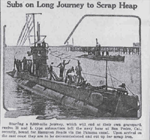 | NR | Starting a 5,000-mile journey, which will end at their own graveyard,twelve H and L type submarines left the Navy base at San Pedro, CA, recently, bound for Hampton Roads, VA. through the Panama Canal. Upon arrival on the East coast they are to be decommissioned and cut up for scrap iron. Eleven of the boats were: H-2 (SS-29), H-3 (SS-30), L-5 (SS-44), L-6 (SS-45), L-7 (SS-46), H-4 (SS-147), H-5 (SS-148), H-6 (SS-149), H-7 (SS-150), H-8 (SS-151), H-9 (SS-152). | Image and text provided by Louisiana State University; Baton Rouge, LA Photo from The Weekly Iberian. (New Iberia, La.) 1894-1946, 19 August 1922, Image 2, courtesy of chroniclingamerica.loc.gov. |
|
 | 588k | Four H-boats alongside the tender Beaver (AS-5) probably in July 1922. The only identifiable boats are H-2 (SS-29) & H-5 (SS-148). After reaching San Pedro, Calif., on 14 July 1922, the Beaver received orders to continue on to the east coast. Departing San Pedro on the 25th, Beaver escorted eight H-boats and four L-boats south toward the Panama Canal. As the submarines were small, and suffered from engine breakdowns, the tender had to tow as many as three submarines at a time during the long stretches between ports. The convoy stopped at Magdalena Bay and Acapulco in Mexico and at Corinto, Nicaragua, before mooring at Coco Solo in the Canal Zone on 28 August. Following two weeks of repairs, the convoy transited the canal on 11 September and arrived at Hampton Roads, Va., via Key West, Fla., on the 29th. | Text courtesy of DANFS. USN photo courtesy of Scott Koen & ussnewyork.com. |
|
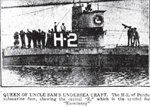 | 52k | QUEEN OF UNCLE SAM'S UNDERSEA CRAFT. The H-2 (SS-29) of Pacific submarine fleet, showing the capital "E," which is the symbol for Excellence. | Image and text provided by Penn State University Libraries; University Park, PA. Photo from Evening Public Ledger. (Philadelphia {Pa.]) 1914-1942, 12 September 1922, Night Extra, Image 32, via chroniclingamerica.loc.gov. |
|
| Back To The Main Photo Index | Back To the Submarine Index |
| Problems and site related matters, E-mail Webmaster |
| This page is created and maintained by Michael Mohl All Pages © 1996 - 2024 NavSource History |